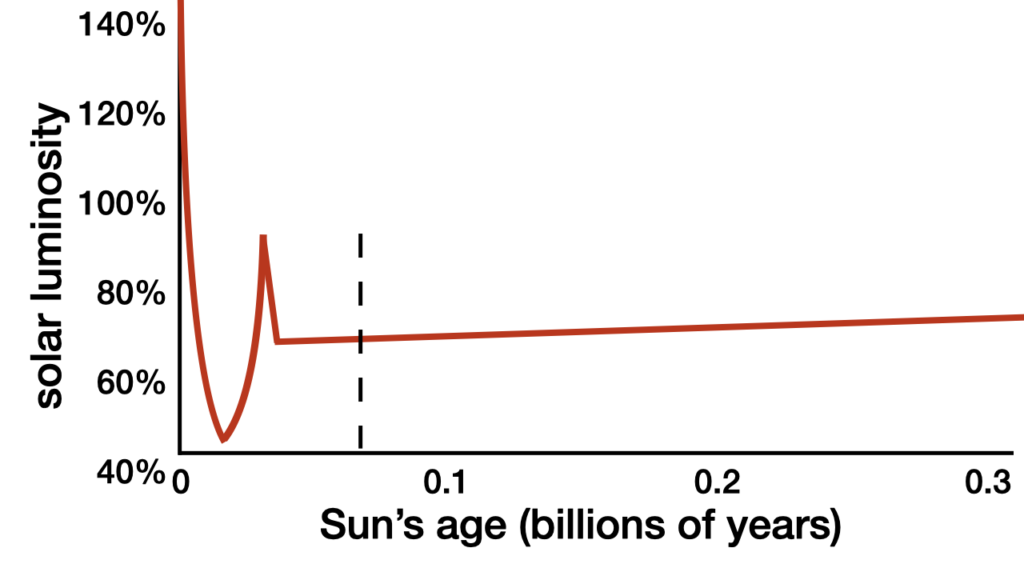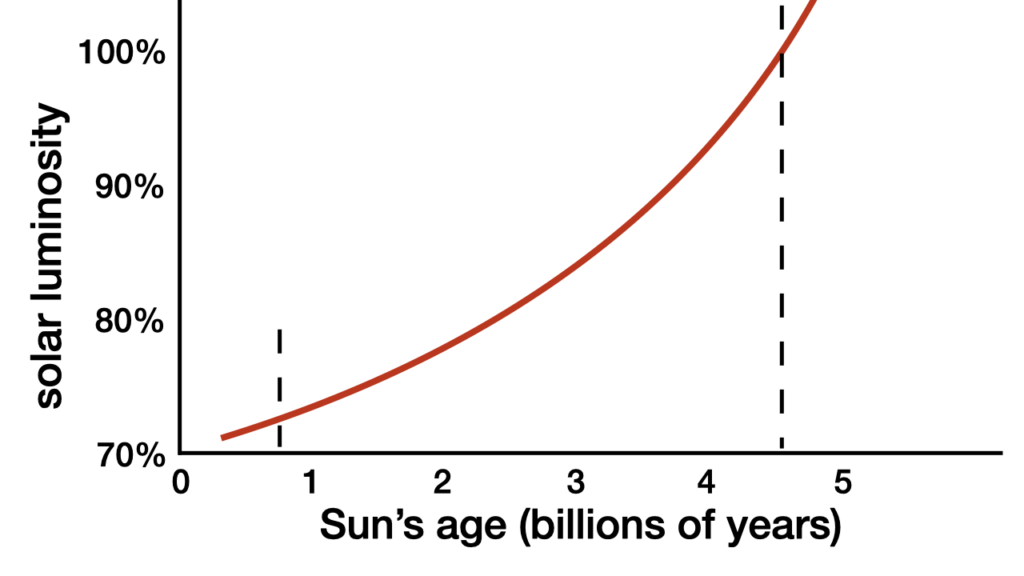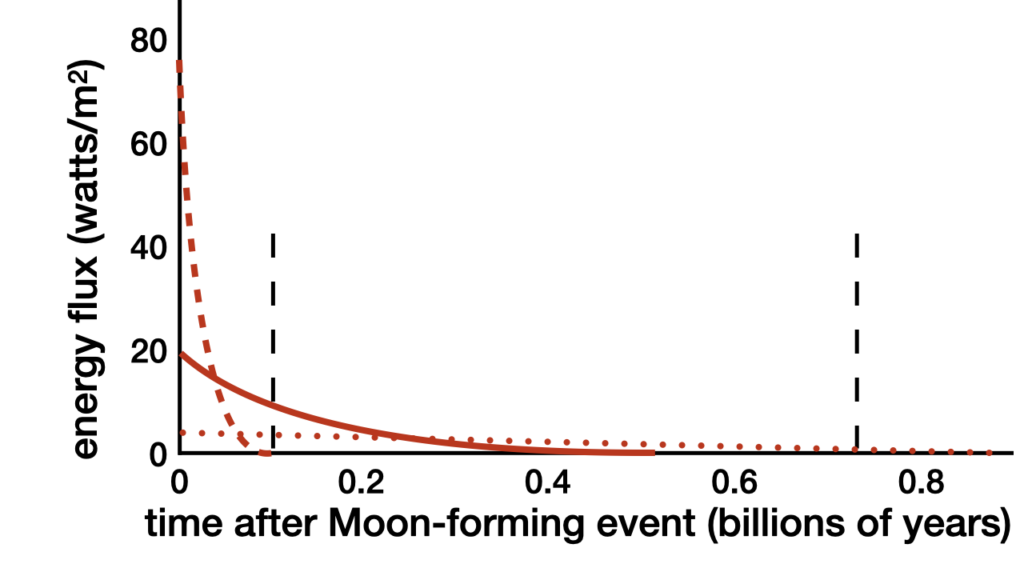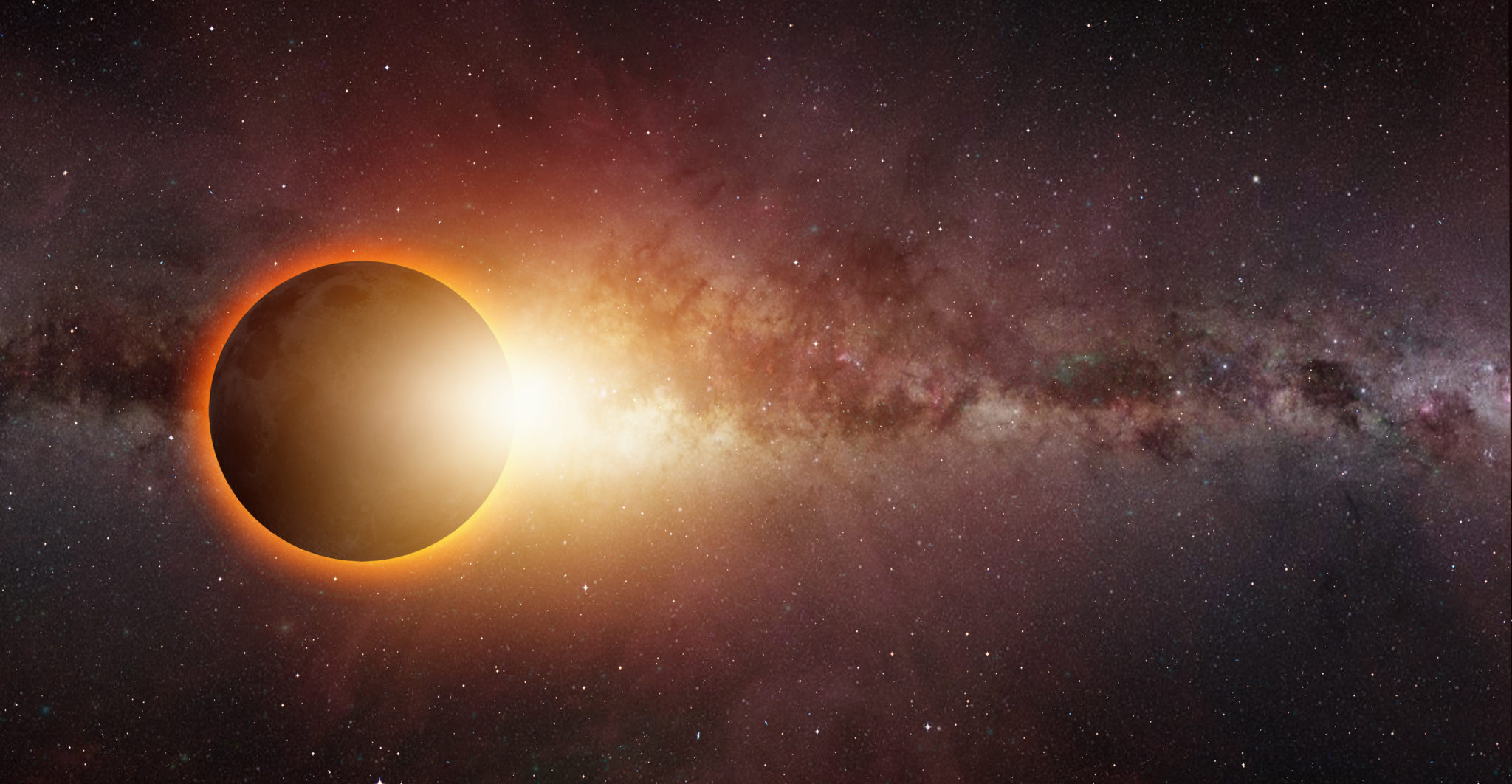Lunar Design for the Origin and History of Life
King David declares in Psalm 8:3, “When I consider your heavens, the work of your fingers, the moon and the stars, which you have set in place . . . ,” and Psalm 89:37 refers to the Moon as “the faithful witness in the sky.” The Moon is mentioned in a total of 42 Bible passages.1 Some of those passages clearly describe the Moon as an object of God’s handiwork that he fashioned for the benefit of humans and Earth’s life and scientific discoveries continue to affirm the Bible’s descriptions.
In the past five years alone, I have written eight articles on the miraculous design features of the Moon that make our existence possible.2 And for my upcoming book, I wrote a lengthy chapter on the Moon’s latest discovered designs.3 Now, a team of five planetary astronomers and geophysicists led by René Heller have described yet another of the Moon’s amazing design characteristics.4
Sun’s Luminosity History
Before the Sun’s nuclear furnace ignited the fusion of hydrogen into helium, the Sun experienced complex variations in its luminosity. A team of astrophysicists led by Isabelle Baraffe calculated these variations based on a detailed solar evolution model they developed.5
The ignition of nuclear fusion of hydrogen into helium causes the Sun to become progressively brighter. Helium is denser than hydrogen. Hence, the density of the Sun’s core has continuously increased since the beginning of nuclear fusion of hydrogen into helium. This increasing core density causes the Sun’s nuclear fusion furnace to become more and more efficient. This progressively enhanced efficiency results in the Sun becoming continuously brighter in a highly predictable way.

The solar luminosity is shown relative to the Sun’s present luminosity. The dashed vertical line indicates the date for the Moon formation event. Diagram constructed from solar evolution model in Isabelle Baraffe et al, “New Evolutionary Models for Pre-Main Sequence and Main Sequence Low-Mass Stars Down to the Hydrogen-Burning Limit,” Astronomy and Astrophysics 577 (May 2015): id. A42, doi:10.1051/0004-6361/201425481.
Figure 1 shows the Sun’s luminosity history during the first 300 million years after its initial formation.6 About 69 million years after the birth of the Sun and the Sun’s planets (4.498 billion years ago), the merger of two rocky planets—the proto-Earth and Theia—occurred.7 This merger increased Earth’s mass and formed the Moon. From the time of this event until 250 million years thereafter (4.248 billion years ago), the Sun’s luminosity was only 68–71% of what it is today.

The solar luminosity is shown relative to the Sun’s present luminosity. The dashed line to the left indicates the date for the origin of life on Earth. The dashed line to the right indicates the present. Diagram constructed from solar evolution model in Isabelle Baraffe et al, “New Evolutionary Model for Pre-Main Sequence and Main Sequence Low-Mass Stars Down to the Hydrogen-Burning Limit,” Astronomy & Astrophysics 577 (May 2015): id. A42, doi:10.1051/0004-6361/201425481.
Figure 2 shows the Sun’s luminosity from 300 million years after its birth until (what it’s expected to be) 200 million years after the present. At the time of life’s origin, the Sun’s luminosity was 73% of what it is today. But with such a faint young Sun, how could early Earth support life?
Tidal Heating from the Moon
In chapter 12 of my book Improbable Planet, I explained how the paradox of the faint young Sun could be resolved.8 The resolution requires the combination of at least a dozen out of 16 compensating factors operating simultaneously to prevent the global mean temperature on Earth’s surface at that time from dropping below that needed for the survival of life. Heller’s team has discovered an additional factor, one that may be important when the Sun is most dim: geothermal heating induced by tidal deformation of Earth by the newly formed Moon. A present-day example of such heating can be seen in the volcanic activity induced on Jupiter’s moon Io as a consequence of Jupiter’s tidal forces.
Presently, the tidal heating of Earth’s surface by the Moon is trivial, owing to the fact that the Moon orbits Earth at too great a distance, 60.3 Earth radii. However, the best models show that the Moon probably orbited Earth as close as 3.8 Earth radii following the Moon formation event.9 At this distance, the tidal heating of Earth’s surface becomes significant. As the Moon spirals away from Earth, this heating effect lessens dramatically.
Astronomers had previously estimated that by the time the Moon was 10 million years old, the tidal heating of Earth’s surface fell below 100 watts/meter2 and by the time the Moon was 100 million years old this tidal heating dropped below 0.1 watt/meter2.10 For comparison, the Sun’s heat presently warms Earth’s surface by an average of 240 watts/meter2.11 At the time the Moon formed, the Sun’s heat warmed Earth’s surface by an estimated average of about 160 watts/meter2.
Heller’s team performed a set of updated calculations on tidal heating from the Moon during the first billion years of Earth’s history. They noted that tidal heat dissipation is greater for viscous objects and that a partly molten early Earth would be considerably more viscous than it is today. They also demonstrated that tidal heating from the Moon would be much greater for a faster-rotating early Earth. They then cited the work of planetary astronomer Robin Canup, who showed that the post-impact Earth likely had a rotation rate as rapid as 2.2 hours.12 Taking into account this new understanding of the early Earth’s characteristics, Heller’s team produced three models for the tidal heating of Earth’s surface based on three different choices for Earth’s initial rotation rate and a reasonable range of possible values for the viscosity of the early Earth (see figure 3).

The black vertical dashed line to the left indicates when liquid water first appeared on Earth. The black vertical dashed line to the right indicates the date for life’s origin on Earth. Diagram constructed by Hugh Ross from models presented in Heller et al., “Habitability of the Early Earth: Liquid Water under a Faint Young Sun Facilitated by Strong Tidal Heating Due to a Nearby Moon,” (July 9, 2020), preprint,
Philosophical Implications of the Tidal Heating
All three models show that at the best established date for the origin of life on Earth, 3.825 ± 0.006 billion years ago,13 the contribution of tidal heating from the Moon on Earth’s surface temperature had declined to a trivial amount. However, for two of the models tidal heating was not trivial at the earliest possible date—4.4 billion years ago—for which geochemists have evidence for the existence of episodic liquid water on some regions of Earth’s surface.14
In their paper, Heller and his colleagues discuss that while lunar tidal heat would not have been the dominant heat source on Earth’s surface 4.4 billion years ago, it probably was a crucial source that made the existence of liquid water at that time possible. What they do not discuss is that the presence of liquid water that early in Earth’s history likely was a critical step in establishing chemical conditions that 0.6 billion years later would allow newly created life to exist and thrive, paving the way for the eventual emergence of advanced life on Earth. For example, the presence of episodic liquid water 4.4–3.9 billion years ago produced phosphates and nitrates, both of which are essential nutrients for living organisms. The Heller team’s discoveries yield yet more evidence that we owe our existence to the many amazingly designed features of the Earth-Moon system.
Endnotes
- “42 Bible Verses about Moon,” Knowing Jesus, accessed September 15, 2021.
- Hugh Ross, “Earth-Moon Coupled Magnetosphere Paved the Way for Life,” Today’s New Reason to Believe (blog), September 20, 2021; Hugh Ross, “Moon’s Early Magnetic Field Made Human Existence Possible,” Today’s New Reason to Believe (blog), November 16, 2020; Hugh Ross, “More Treasures in Earth’s Attic,” Today’s New Reason to Believe (blog), September 21, 2020; Hugh Ross, “Update on Our Miraculous Moon,” Today’s New Reason to Believe (blog), August 31, 2020; Hugh Ross, “Solar and Lunar Tides Designed for Complex Life,” Today’s New Reason to Believe (blog), March 25, 2019; Hugh Ross, “Lunar Designs Optimize Life for Both Predators and Prey,” Today’s New Reason to Believe (blog), November 20, 2017; Hugh Ross, “Rare Moon Just Got Rarer,” Today’s New Reason to Believe (blog), June 5, 2017; Hugh Ross, “Yet More Reasons to Thank God for the Moon,” Today’s New Reason to Believe (blog), November 22, 2016.
- Hugh Ross, Designed to the Core (Covina, CA: RTB Press, forthcoming), chapter 13.
- René Heller et al., “Habitability of the Early Earth: Liquid Water under a Faint Young Sun Facilitated by Strong Tidal Heating Due to a Nearby Moon,” (July 9, 2020), preprint, arXiv:2007.03423v2.
- Isabelle Baraffe et al., “New Evolutionary Models for Pre-Main Sequence and Main Sequence Low-Mass Stars Down to the Hydrogen-Burning Limit,” Astronomy & Astrophysics 577 (May 2015): id. A42, doi:10.1051/0004-6361/201425481.
- Baraffe et al., “New Evolutionary Models.”
- Alessandro Maltese and Klaus Mezger, “The Pb Isotope Evolution of Bulk Silicate Earth: Constraints from Its Accretion and Early Differentiation History,” Geochimica et Cosmochimica Acta 271 (February 15, 2020): 179–193, doi:10.1016/j.gca.2019.12.021.
- Hugh Ross, Improbable Planet (Grand Rapids, MI: Baker Books, 2016), 143–159.
- Robin M. Canup, “Simulations of a Late Lunar-Forming Impact,” Icarus 168, no. 2 (April 2004): 433–456, doi:10.1016/j.icarus.2003.09.028.
- Kevin Zahnle et al., “Emergence of a Habitable Planet,” Space Science Reviews 129, nos. 1–3 (March 2007): 35–78, doi:10.1007/s11214-007-9225-z.
- Graeme L. Stephens et al., “An Update on Earth’s Energy Balance in Light of the Latest Global Observations,” Nature Geoscience 5 (October 2012): 691–696, doi:10.1038/ngeo1580.
- Robin M. Canup, “Forming a Moon with an Earth-Like Composition via a Giant Impact,” Science 338, no. 6110 (November 23, 2012): 1052–1055, doi:10.1126/science.1226073.
- Craig E. Manning, Stephen J. Mojzsis, and T. Mark Harrison, “Geology, Age and Origin of Supracrustal Rocks at Akilia, West Greenland,” American Journal of Science 306, no. 5 (May 2006): 303–366, doi:10.2475/05.2006.02.
- Simon A. Wilde et al, “Evidence from Detrital Zircons for the Existence of Continental Crust and Oceans on the Earth 4.4 Gyr Ago,” Nature 409, no. 6817 (January 11, 2001): 175–178, doi:10.1038/35051550; Stephen J. Mojzsis, T. Mark Harrison, and Robert T. Pidgeon, “Oxygen-Isotope Evidence from Ancient Zircons for Liquid Water at the Earth’s Surface 4,300 Myr Ago,” Nature 409, no. 6817 (January 11, 2001): 178–181, doi:10.1038/35051557; John W. Valley et al., “Hadean Age for a Post-Magma-Ocean Zircon Confirmed by Atom-Probe Tomography,” Nature Geoscience 7, no. 3 (March 2014): 219–223, doi:10.1038/ngeo2075.






